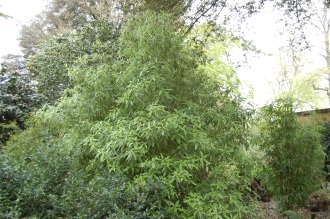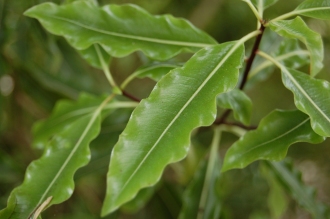Position: Full sun to light shade
Flowering period: Spring
Soil: Moist, well drained
Eventual Height: 12m
Eventual Spread: 5m
Hardiness: 8b, 9a, 9b, 10a, 10b
Family: Pittosporaceae
Pittosporum eugenioides is an evergreen tree with a conical habit when young, maturing to rounded. Its glossy, leathery mid green green leaves are lanceolate to ovate with entire wavy margins, up to 10cm long and 4cm brad. Its leaves have a lemon smell when crushed. Its yellow/ cream fragrant hermaphrodite flowers are bell shaped are produced in clusters. Its fruit is a black woody seed capsule, which bursts on ripening to release the numerous seeds.
Pittosporum eugenioides, commonly known as Lemonwood or Tarata, is native to New Zealand. In its native habitat it grows at forests margins of both the North and South Islands up to an altitude of 600m.
The etymological root of the binomial name Pittosporum is derived from the Greek pitte meaning ‘tar’ and sporos meaning ‘seed’, describing the sticky seed capsules. Eugenioides is derived from the Latin meaning ‘like a Eugenia (another genus of plant)’.
The landscape architect may find Pittosporum eugenioides useful as an evergreen small tree with sweetly scented flowers.
Ecologically, Pittosporum eugenioides flowers are attractive to pollinating insects.
The Royal Horticultural Society has given the variety Pittosporum eugenioides ‘Variegatum’ their prestigious Award of Garden Merit in 1993.
Pittosporum eugenioides prefers moist, fertile, well-drained soils. It tolerates most pH of soil.
Pittosporum eugenioides requires little maintenance.






Leave a comment